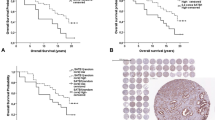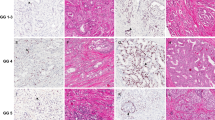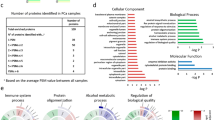Abstract
The QM protein is a transcription cofactor inhibiting the activity of AP-1 transcription factors and is also a ribosomal protein participating in protein synthesis. While protein synthesis is known to be increased in many cancers, inhibition of AP-1 activity presumably suppresses development and growth of sex-hormone-regulated tumor cells. The present study is the first report on immunohistochemical data of QM in human prostatic tissues. Paraffin sections of human prostate cancer samples were immunohistochemically stained for QM. The staining scores were analyzed with the clinicopathologic data of the patients. QM protein expression was found in all normal prostate glands adjacent to prostate cancer and in various intraepithelial neoplasia (PIN). In prostate cancer, the staining intensity and stained areas were decreased, compared to the normal glands and PIN lesions; in high-grade tumors only some patches of tumor cells showed positivity. Intense (3+) staining was mostly observed in the Gleason grade three areas (48%) compared to grade 4 and 5 areas (22%), although both low and high-grade tumors showed similar percentages of weakly stained areas. Moreover, staining in prostatic adenocarcinoma was often topographically patchy and varied from negative or weak (1+) to intense (3+). There was an inverse correlation from normal to low-grade tumors and then to high-grade tumors. However, in high-grade tumors, the positive areas were mostly confined to peripheral aspects of tumors and were particularly strong in foci of perineural invasion. This preliminary study suggests that decreased QM expression may be associated with early development of prostate cancer, but later a high level of QM may facilitate progression of the tumors to a more aggressive phenotype.
This is a preview of subscription content, access via your institution
Access options
Subscribe to this journal
Receive 4 print issues and online access
$259.00 per year
only $64.75 per issue
Buy this article
- Purchase on Springer Link
- Instant access to full article PDF
Prices may be subject to local taxes which are calculated during checkout

Similar content being viewed by others
References
Dowdy SF, Lai KM, Weissman BE, Matsui Y, Hogan BL, Stanbridge EJ . The isolation and characterization of a novel cDNA demonstrating an altered mRNA level in nontumorigenic Wilms’ microcell hybrid cells. Nucleic Acids Res 1991; 19: 5763–5769.
Dowdy SF, Fasching CL, Araujo D, Lai KM, Livanos E, Weissman BE et al. Suppression of tumorigenicity in Wilms tumor by the p15.5-p14 region of chromosome 11. Science 1991; 254: 293–295.
van den Ouweland AM, Verdijk M, Mannens MM, van Oost BA . The QM gene is X-linked and therefore not involved in suppression of tumorigenesis in Wilms’ tumor. Hum Genet 1992; 90: 144–146.
Dowdy SF, Lai KM, Weissman BE, Matsui Y, Hogan BL, Stanbridge EJ . The isolation and characterization of a novel cDNA demonstrating an altered mRNA level in nontumorigenic Wilms’ microcell hybrid cells. Nucleic Acids Res 1991; 19: 5763–5769.
Eisinger DP, Jiang HP, Serrero G . A novel mouse gene highly conserved throughout evolution: regulation in adipocyte differentiation and in tumorigenic cell lines. Biochem Biophys Res Commun 1993; 196: 1227–1232.
Farmer AA, Loftus TM, Mills AA, Sato KY, Neill JD, Tron T et al. Extreme evolutionary conservation of QM, a novel c-Jun associated transcription factor. Hum Mol Genet 1994; 3: 723–728.
Monteclaro FS, Vogt PK . A Jun-binding protein related to a putative tumor suppressor. Proc Natl Acad Sci USA 1993; 90: 6726–6730.
Stanbridge E, Farmer A, Mills A, Loftus T, Kongkasuriyachai D, Dowdy S et al. Molecular characterization of QM, a novel gene with properties consistent with tumor suppressor function. Cold Spring Harb Symp Quant Biol 1994; 59: 573–576.
Loftus TM, Nguyen YH, Stanbridge EJ . The QM protein associates with ribosomes in the rough endoplasmic reticulum. Biochemistry 1997; 36: 8224–8230.
Inada H, Mukai J, Matsushima S, Tanaka T . QM is a novel zinc-binding transcription regulatory protein: its binding to c-Jun is regulated by zinc ions and phosphorylation by protein kinase C. Biochem Biophys Res Commun 1997; 230: 331–334.
Edwards J, Krishna NS, Mukherjee R, Bartlett JM . The role of c-Jun and c-Fos expression in androgen-independent prostate cancer. J Pathol 2004; 204: 153.
Webb P, Nguyen P, Valentine C, Lopez GN, Kwok GR, McInerney E et al. The estrogen receptor enhances AP-1 activity by two distinct mechanisms with different requirements for receptor transactivation functions. Mol Endocrinol 1999; 13: 1672–1685.
Imafuku I, Masaki T, Waragai M, Takeuchi S, Kawabata M, Hirai S et al. Presenilin 1 suppresses the function of c-Jun homodimers via interaction with QM/Jif-1. J Cell Biol 1999; 147: 121–134.
Nguyen YH, Mills AA, Stanbridge EJ . Assembly of the QM protein onto the 60S ribosomal subunit occurs in the cytoplasm. J Cell Biochem 1998; 68: 281–285.
Koller HT, Klade T, Ellinger A, Breitenbach M . The yeast growth control gene GRC5 is highly homologous to the mammalian putative tumor suppressor gene QM. Yeast 1996; 12: 53–65.
Tron T, Yang M, Dick FA, Schmitt ME, Trumpower BL . QSR1, an essential yeast gene with a genetic relationship to a subunit of the mitochondrial cytochrome bc1 complex, is homologous to a gene implicated in eukaryotic cell differentiation. J Biol Chem 1995; 270: 9961–9970.
Mills AA, Mills MJ, Gardiner DM, Bryant SV, Stanbridge EJ . Analysis of the pattern of QM expression during mouse development. Differentiation 1999; 64: 161–171.
Oh HS, Kwon H, Sun SK, Yang CH . QM, a putative tumor suppressor, regulates proto-oncogene c-yes. J Biol Chem, (E-pub. 2002 Jul 22) 2002; 277: 36489–36498.
Mills AA, Mills MJ, Gardiner DM, Bryant SV, Stanbridge EJ . Analysis of the pattern of QM expression during mouse development. Differentiation 1999; 64: 161–171.
Loftus TM, Nguyen YH, Stanbridge EJ . The QM protein associates with ribosomes in the rough endoplasmic reticulum. Biochemistry 1997; 36: 8224–8230.
Mills AA, Mills MJ, Gardiner DM, Bryant SV, Stanbridge EJ . Analysis of the pattern of QM expression during mouse development. Differentiation 1999; 64: 161–171.
Dowdy SF, Lai KM, Weissman BE, Matsui Y, Hogan BL, Stanbridge EJ . The isolation and characterization of a novel cDNA demonstrating an altered mRNA level in nontumorigenic Wilms’ microcell hybrid cells. Nucleic Acids Res 1991; 19: 5763–5769.
Eisinger DP, Jiang HP, Serrero G . A novel mouse gene highly conserved throughout evolution: regulation in adipocyte differentiation and in tumorigenic cell lines. Biochem Biophys Res Commun 1993; 196: 1227–1232.
Liao DJ, Dickson RB . Cell death in MMTV-c-myc transgenic mouse mammary tumors may not be typical apoptosis. Lab Invest 2003; 83: 1437–1449.
Monteclaro FS, Vogt PK . A Jun-binding protein related to a putative tumor suppressor. Proc Natl Acad Sci USA 1993; 90: 6726–6730.
Villers A, McNeal JE, Redwine EA, Freiha FS, Stamey TA . The role of perineural space invasion in the local spread of prostatic adenocarcinoma. J Urol 1989; 142: 763–768.
Karan D, Kelly DL, Rizzino A, Lin MF, Batra SK . Expression profile of differentially-regulated genes during progression of androgen-independent growth in human prostate cancer cells. Carcinogenesis 2002; 23: 967–975.
Acknowledgements
This work was supported by funds from Karmanos Cancer Institute to Dr DJ Liao.
Author information
Authors and Affiliations
Corresponding author
Rights and permissions
About this article
Cite this article
Altinok, G., Powell, I., Che, M. et al. Reduction of QM protein expression correlates with tumor grade in prostatic adenocarcinoma. Prostate Cancer Prostatic Dis 9, 77–82 (2006). https://doi.org/10.1038/sj.pcan.4500848
Received:
Accepted:
Published:
Issue Date:
DOI: https://doi.org/10.1038/sj.pcan.4500848
Keywords
This article is cited by
-
The ufmylation modification of ribosomal protein L10 in the development of pancreatic adenocarcinoma
Cell Death & Disease (2023)
-
Improved identification of core biomarkers and drug repositioning for ovarian cancer: an integrated bioinformatics approach
Network Modeling Analysis in Health Informatics and Bioinformatics (2020)



